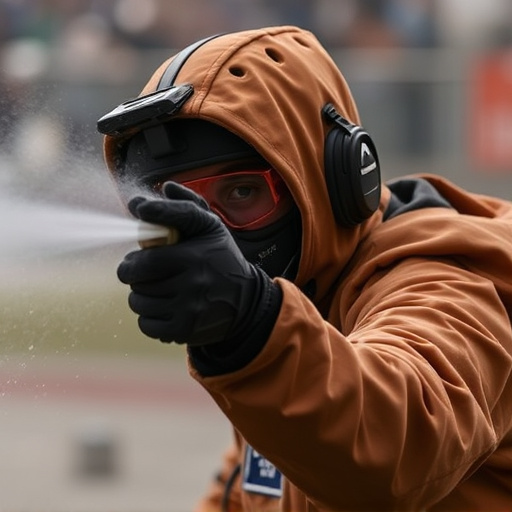Pepper spray, a non-lethal law enforcement tool, uses capsaicin from chili peppers to cause temporary disorientation and pain without blinding users. While it doesn't aim to blind, direct eye exposure can lead to severe irritation and blurriness lasting minutes. It's primarily used as a last resort in crowd control, requiring careful deployment by trained professionals following strict protocols to minimize harm and respect civil liberties.
“In recent years, pepper spray has emerged as a controversial yet widely used tool in crowd control by law enforcement agencies. This chemical agent, designed to incapacitate and disrupt, raises significant questions regarding its effectiveness and potential risks. From understanding its mechanism of action to examining when its use is justified, this article delves into the intricacies of police pepper spray deployment, focusing on the critical query: can pepper spray blind you? Unraveling these complexities is essential for both public safety and informed discourse.”
- What is Pepper Spray and How Does it Work?
- Police Use of Pepper Spray: When is it Justified?
- Can Pepper Spray Blind You? Understanding the Risks.
What is Pepper Spray and How Does it Work?
Pepper spray, also known as oleoresin capsicum (OC) spray, is a non-lethal crowd control agent used by law enforcement agencies worldwide. It’s a liquid substance derived from chili peppers that, when aerosolized, releases capsaicin, the active ingredient responsible for its pungent and burning effects. When sprayed, it irritates the eyes, nose, throat, and skin, causing temporary disorientation and immobilization. However, it’s crucial to clarify that pepper spray does not blind you; while it significantly reduces visibility, it doesn’t cause permanent blindness.
The mechanism behind pepper spray’s effectiveness lies in its ability to disrupt normal cellular function by binding to vanilloid receptors in the body, particularly those found in sensory neurons. This reaction triggers a cascade of events leading to localized pain and discomfort. Its non-lethal nature makes it a preferred option for crowd dispersion, as it allows officers to control and subdue individuals without causing severe harm.
Police Use of Pepper Spray: When is it Justified?
Police use pepper spray, also known as oleoresin capsicum (OC) spray, as a non-lethal weapon to control and disperse crowds during demonstrations or public disturbances. While it’s an effective tool for crowd management, its use comes with careful consideration and justification. Law enforcement agencies must adhere to strict protocols when deploying pepper spray, ensuring minimal harm to bystanders and respect for civil liberties.
The decision to use pepper spray should be a last resort when other de-escalation tactics have failed or when the situation poses an imminent threat to public safety. Officers are trained to assess the intensity of the crowd, their own safety, and the potential risk of injury before deploying OC spray. It’s crucial to understand that pepper spray is not designed to “blind” individuals but rather to cause a temporary sensation of pain, burning, and difficulty breathing, prompting individuals to leave the area. However, direct exposure to the eyes can cause severe irritation or even temporary blindness, so officers must be cautious in their application.
Can Pepper Spray Blind You? Understanding the Risks.
Many people wonder, can pepper spray blind you? It’s a valid concern, especially during protests or other situations where crowd control measures are employed. While pepper spray is designed to disrupt and disperse crowds by causing temporary blindness, pain, and difficulty breathing, its effects vary greatly from person to person. The active ingredient in pepper spray, capsaicin, irritates the eyes, nose, throat, and lungs, but it does not cause permanent blindness.
However, direct exposure to the eyes can result in severe irritation, tears, redness, and temporary blurriness that may last for several minutes. Individuals wearing contact lenses are at higher risk of experiencing more intense eye discomfort or even damage. It’s crucial to understand that pepper spray is a powerful tool that should only be used when necessary by trained professionals who follow safety protocols to minimize risks, including proper ventilation and use of protective gear.
While pepper spray is a widely used tool for crowd control, it’s crucial to understand its potential risks, including the possibility of temporary blindness. As police agencies deploy this agent, being aware of when and how it’s used can help ensure public safety without exacerbating situations. Remember that informed consent and proportionality are key in any use of force, especially with non-lethal tools like pepper spray.
